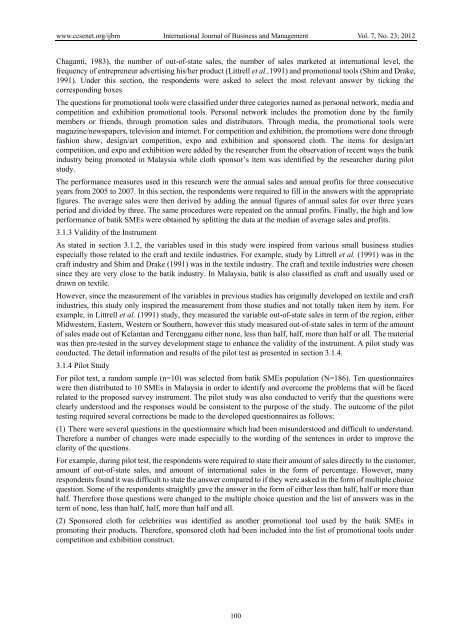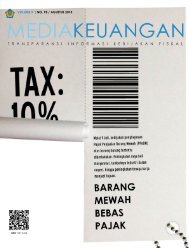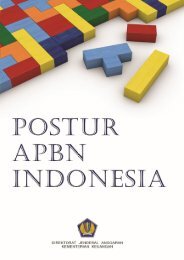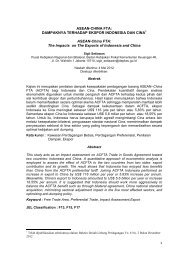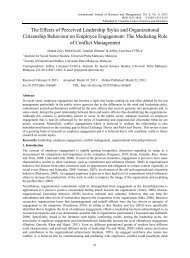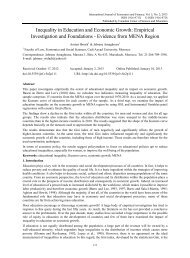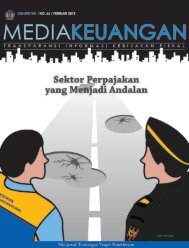Marketing%20Strategies%20and%20the%20Difference%20Level%20of%20Sales%20and%20Profits
Marketing%20Strategies%20and%20the%20Difference%20Level%20of%20Sales%20and%20Profits
Marketing%20Strategies%20and%20the%20Difference%20Level%20of%20Sales%20and%20Profits
Create successful ePaper yourself
Turn your PDF publications into a flip-book with our unique Google optimized e-Paper software.
www.ccsenet.org/ijbm International Journal of Business and Management Vol. 7, No. 23; 2012<br />
Chaganti, 1983), the number of out-of-state sales, the number of sales marketed at international level, the<br />
frequency of entrepreneur advertising his/her product (Littrell et al.,1991) and promotional tools (Shim and Drake,<br />
1991). Under this section, the respondents were asked to select the most relevant answer by ticking the<br />
corresponding boxes<br />
The questions for promotional tools were classified under three categories named as personal network, media and<br />
competition and exhibition promotional tools. Personal network includes the promotion done by the family<br />
members or friends, through promotion sales and distributors. Through media, the promotional tools were<br />
magazine/newspapers, television and internet. For competition and exhibition, the promotions were done through<br />
fashion show, design/art competition, expo and exhibition and sponsored cloth. The items for design/art<br />
competition, and expo and exhibition were added by the researcher from the observation of recent ways the batik<br />
industry being promoted in Malaysia while cloth sponsor’s item was identified by the researcher during pilot<br />
study.<br />
The performance measures used in this research were the annual sales and annual profits for three consecutive<br />
years from 2005 to 2007. In this section, the respondents were required to fill in the answers with the appropriate<br />
figures. The average sales were then derived by adding the annual figures of annual sales for over three years<br />
period and divided by three. The same procedures were repeated on the annual profits. Finally, the high and low<br />
performance of batik SMEs were obtained by splitting the data at the median of average sales and profits.<br />
3.1.3 Validity of the Instrument<br />
As stated in section 3.1.2, the variables used in this study were inspired from various small business studies<br />
especially those related to the craft and textile industries. For example, study by Littrell et al. (1991) was in the<br />
craft industry and Shim and Drake (1991) was in the textile industry. The craft and textile industries were chosen<br />
since they are very close to the batik industry. In Malaysia, batik is also classified as craft and usually used or<br />
drawn on textile.<br />
However, since the measurement of the variables in previous studies has originally developed on textile and craft<br />
industries, this study only inspired the measurement from those studies and not totally taken item by item. For<br />
example, in Littrell et al. (1991) study, they measured the variable out-of-state sales in term of the region, either<br />
Midwestern, Eastern, Western or Southern, however this study measured out-of-state sales in term of the amount<br />
of sales made out of Kelantan and Terengganu either none, less than half, half, more than half or all. The material<br />
was then pre-tested in the survey development stage to enhance the validity of the instrument. A pilot study was<br />
conducted. The detail information and results of the pilot test as presented in section 3.1.4.<br />
3.1.4 Pilot Study<br />
For pilot test, a random sample (n=10) was selected from batik SMEs population (N=186). Ten questionnaires<br />
were then distributed to 10 SMEs in Malaysia in order to identify and overcome the problems that will be faced<br />
related to the proposed survey instrument. The pilot study was also conducted to verify that the questions were<br />
clearly understood and the responses would be consistent to the purpose of the study. The outcome of the pilot<br />
testing required several corrections be made to the developed questionnaires as follows:<br />
(1) There were several questions in the questionnaire which had been misunderstood and difficult to understand.<br />
Therefore a number of changes were made especially to the wording of the sentences in order to improve the<br />
clarity of the questions.<br />
For example, during pilot test, the respondents were required to state their amount of sales directly to the customer,<br />
amount of out-of-state sales, and amount of international sales in the form of percentage. However, many<br />
respondents found it was difficult to state the answer compared to if they were asked in the form of multiple choice<br />
question. Some of the respondents straightly gave the answer in the form of either less than half, half or more than<br />
half. Therefore those questions were changed to the multiple choice question and the list of answers was in the<br />
term of none, less than half, half, more than half and all.<br />
(2) Sponsored cloth for celebrities was identified as another promotional tool used by the batik SMEs in<br />
promoting their products. Therefore, sponsored cloth had been included into the list of promotional tools under<br />
competition and exhibition construct.<br />
100


